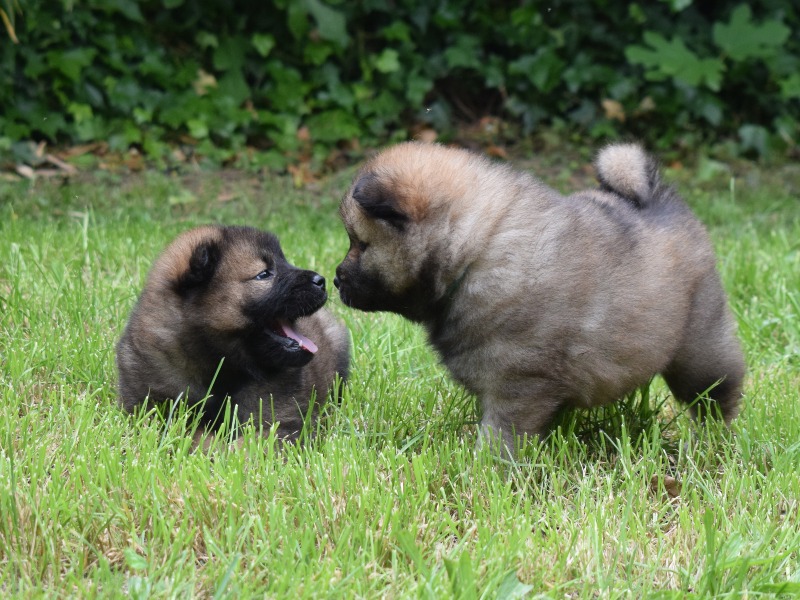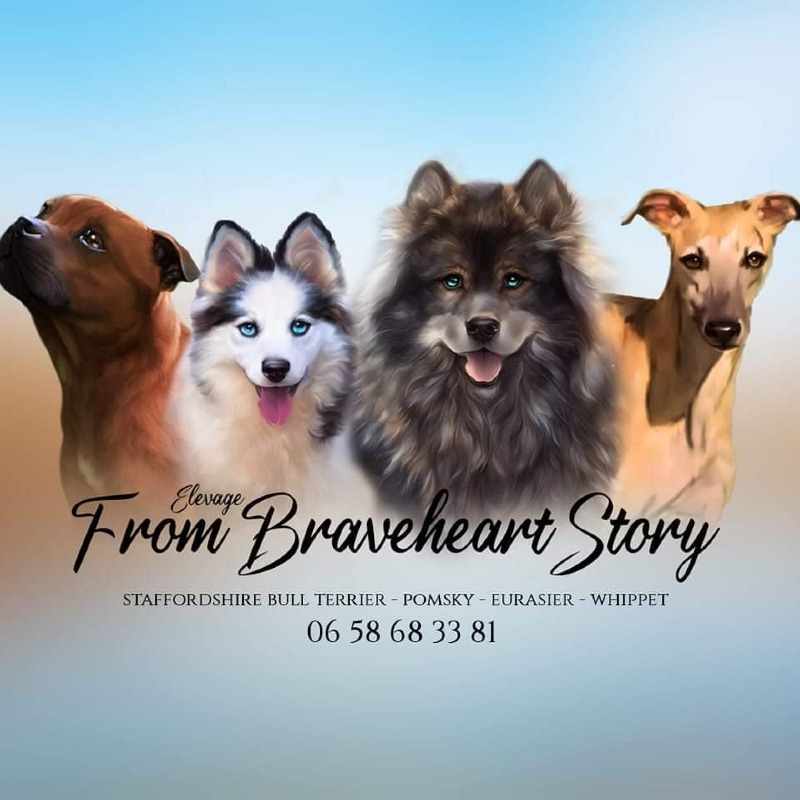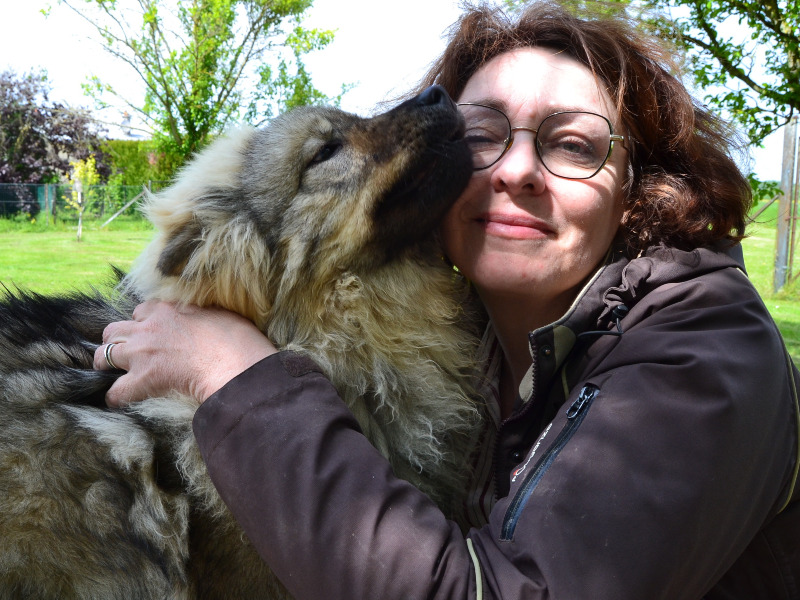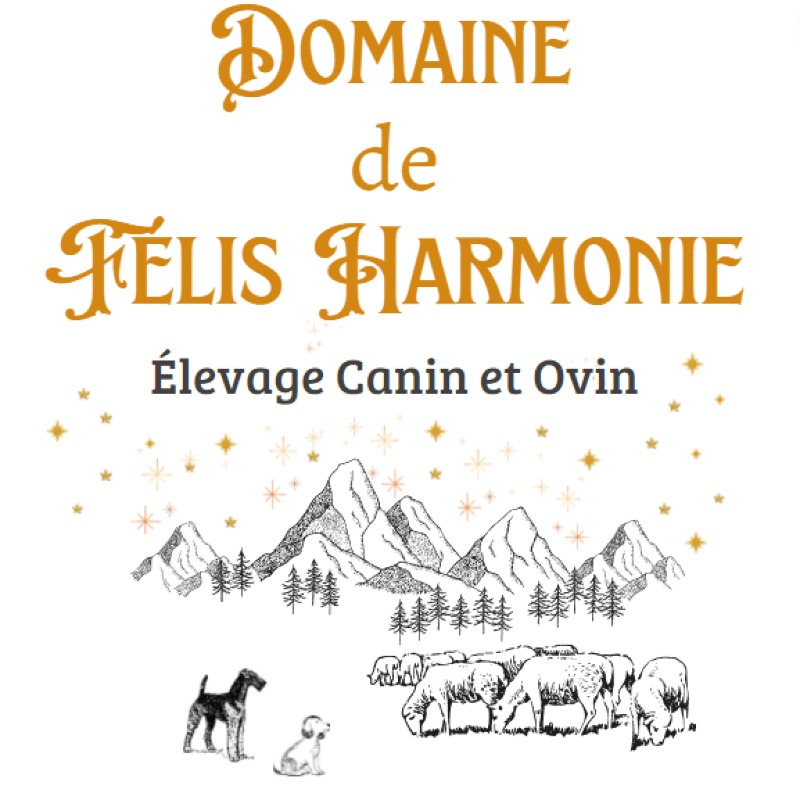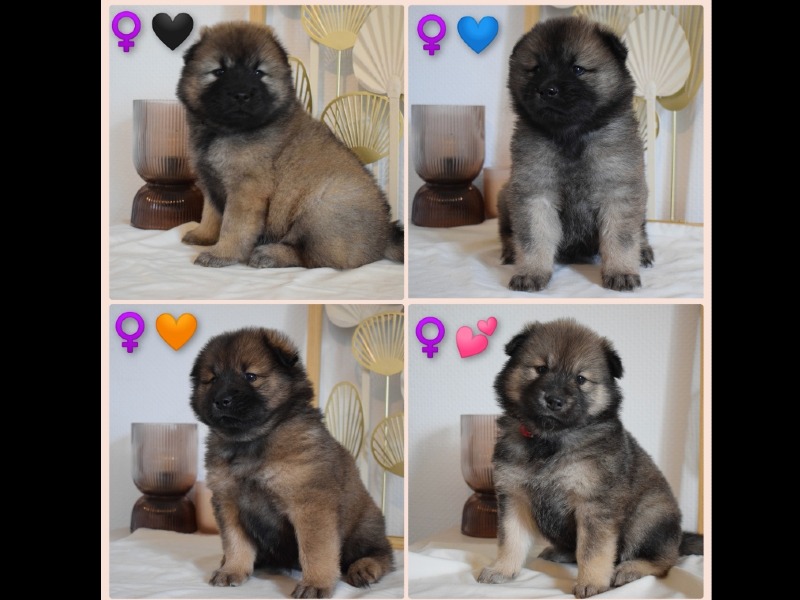Eurasian
Autres noms : Eurasier
Discover the Eurasier, a balanced and affectionate dog breed known for its thick coat and gentle temperament. Ideal for families, it combines loyalty and intelligence, making it an exceptional companion.
Awareness of acquiring an animal
Adopting or breeding a dog is a responsibility that must be carefully considered. Dogs are loyal companions that require time, attention, and constant care. Whether for leisure, passion, or professional breeding, it is crucial to understand the specific needs of each breed. Provide them with a loving and stimulating environment, and avoid any impulsive acquisition that could harm their well-being. Be a vigilant and committed owner for a happy and healthy companion.
To learn more about animal welfare, we invite you to consult our FAQ by clicking the button below:
Origins and history
The Eurasier dog is a relatively recent breed, developed in the 1960s in Germany. Its origins lie in a mix of breeds, including the Chow Chow, Samoyed, and Spitz, with the aim of creating a companion dog that is both loyal and balanced. Breeder Julius Wipfel wanted to create a breed capable of adapting to various living conditions while maintaining a gentle and affectionate personality.
Over the decades, the Eurasier has gained popularity in Europe and America, thanks to its friendly nature and independent character. Known for its dense coat and majestic appearance, it is often described as a medium-sized dog with great elegance.
This breed is distinguished by its balanced temperament, making it an excellent companion for families. Its sociability, loyalty, and protective instincts make it a cherished dog in many households. Additionally, its adaptability allows it to thrive in both urban and rural environments, making the Eurasier particularly versatile.
Physical characteristics
The Eurasier is a medium-sized dog with a robust and well-proportioned stature. Its weight typically ranges from 18 to 32 kg, while its height at the withers stands between 48 and 60 cm. This dog displays a well-developed musculature, emphasizing its strength and endurance.
Its coat is one of its most remarkable features. It is dense, double, and weather-resistant, with a soft undercoat that provides good insulation. Coat colors range from black, gray, and chocolate to red, with various patterns and the possibility of markings. The fur is often longer around the neck, creating a distinctive mane.
The head has a triangular shape, with a broad skull and medium-shaped glasses. The eyes, usually almond-shaped, can be dark or light in color and are expressive, reflecting the lively character of the breed. The ears, triangular and slightly rounded, are typically erect, adding to the alert appearance of the Eurasier. Overall, this dog stands out for its noble and balanced appearance.
Character
The Eurasier is a dog that stands out for its balanced temperament and affection towards its family. It is a loyal and dedicated companion that forms close bonds with its owners. Although generally sociable, it sometimes shows a certain reserve towards strangers, making it a good watchdog. Its protective nature drives it to look after those it loves, without being aggressive.
This dog is intelligent and receptive to training, which makes it easier to educate. However, it requires a gentle and positive approach to bring out the best in itself. Its sensitivity makes it attentive to human emotions, enhancing its ability to adapt to different environments.
Furthermore, the Eurasier has a moderate need for physical activity, thriving in both relaxed walks and more dynamic play. It also enjoys quiet and relaxing moments with its family. In summary, the Eurasier combines loyalty, intelligence, and adaptability, making it an excellent companion for active families and individuals.
Life expectancy
The life expectancy of an Eurasier generally ranges from 12 to 15 years. Like many dog breeds, this lifespan can vary depending on several factors, including genetics, diet, exercise, and veterinary care. Proper health management throughout the animal's life can help maximize its life expectancy.
To ensure the longevity of these dogs, it is essential to provide them with a balanced diet that meets their needs. Quality nutrition not only contributes to their physical health but also strengthens their immune system. Additionally, a regular exercise and mental stimulation program is crucial for maintaining their overall well-being.
Regarding veterinary care, regular check-ups allow for the early detection of potential health issues. Vaccinations, parasite prevention, and regular health assessments play a key role in extending the lives of these companions. A stable and loving environment, coupled with special attention from their owners, will also promote healthy and happy aging.
Exercise and activity needs
The Eurasier is a dog breed that requires specific needs in exercise and activity to maintain its physical and mental well-being. As a medium-sized dog, it requires daily vigorous activity to avoid obesity and promote overall good health. A walk of at least one hour a day, combined with interactive play sessions, is ideal. These dogs love to explore their environment, so outings in nature are particularly beneficial.
In addition to walks, it is essential to offer varied activities. Agility exercises, hiking, and search games not only stimulate their bodies but also their intellect. Eurasier dogs are intelligent and thrive on learning new tricks and through positive reinforcement. This also helps strengthen the bond with their owner.
Finally, it is crucial to take their social nature into account. Eurasier dogs appreciate the company of their family and other dogs. Regular interactions with other animals and play sessions are essential for their development. A balance between physical activity and social interactions is therefore key to a happy and well-adjusted Eurasier.
Recommended diet
The Eurasier is a dog that requires a balanced diet to maintain its health and well-being. Due to its medium size and activity level, it is crucial to provide food that meets its energy needs. High-quality foods, rich in animal proteins, should form the basis of its diet. Protein sources such as chicken, beef, or fish are essential for supporting muscle development and vitality.
In addition to proteins, the Eurasier needs complex carbohydrates for sustained energy. Whole grains such as brown rice or oats, as well as vegetables like carrots and green beans, are excellent options. These carbohydrates also promote healthy digestion. It is advisable to limit simple carbohydrates and artificial additives, which can lead to digestive issues.
Fats also play an important role in the Eurasier's diet. Omega-3 and omega-6 fatty acids, present in fish oils or vegetable oils, contribute to the health of the skin and coat. Finally, it is crucial to ensure that the dog always has access to fresh, clean water. Proper hydration is essential for its overall health.
Training and obedience
Training and educating an Eurasier breed dog requires a thoughtful and gentle approach. This breed is known for its independent instincts and calm temperament, which can make the learning process both rewarding and challenging. It is crucial to start at a young age, as this period is conducive to learning good manners and socialization.
Socialization is particularly important for this breed. It is essential to expose the animal to various environments, people, and other animals to build its confidence and prevent timid or reserved behavior in adulthood. Positive interactions during this phase will help shape a well-balanced character.
When it comes to training, it is best to adopt methods based on positive reinforcement. Eursasians respond better to rewards, whether it be treats, petting, or verbal encouragement, rather than punishments. Patience and consistency are valuable allies, as these dogs can sometimes display indifference to certain commands. Short and fun training sessions help maintain their interest and stimulate their intelligence.
Finally, it is essential to develop a bond of trust with the animal. Encouraging interaction, play, and exploration will foster a harmonious relationship. Education based on mutual understanding will lead to a well-balanced companion who is well integrated into the family.
Behavior with children
The behavior of Eurasier dogs with children is generally positive and caring. This breed is recognized for its balanced temperament and friendly nature. Eurasiers are often very attached to their families and show great affection towards children. They are usually patient and tolerant, which makes them well-suited for a family environment.
However, it is essential to educate children about respecting animals. Even though these dogs are naturally gentle, it is crucial to teach children how to interact with them appropriately. A respectful approach will promote a harmonious relationship. Eurasiers enjoy socialization and can become true playmates for children, contributing to their emotional development.
It is worth noting that each dog has its own personality, and positive interactions also depend on education and training. Early socialization is recommended to ensure that the dog becomes accustomed to children and vice versa. In summary, Eurasiers can be wonderful companions for families, provided that the interactions between the animal and the young ones are appropriately guided.
Compatibility with Other Animals
The Eurasier breed is generally recognized for its sociable and friendly nature, making it a good companion for other pets. Although each dog has a unique temperament, Eurasier dogs tend to get along with other dogs, especially if they are properly socialized from a young age. Early exposure to different breeds, sizes, and temperaments can help reduce territorial or dominant behaviors.
Regarding non-canine pets, such as cats, Eurasier can also coexist harmoniously. However, the dynamic between an Eurasier and a cat may depend on the personality of each. Some Eurasiers will develop good relationships with felines, while others may view them as prey. The key lies in a gradual and supervised introduction.
Socialization is crucial for this breed. Owners should encourage positive interactions and supervise encounters, taking into account the needs and behaviors of each animal. A moderate and structured environment will foster a climate of respect among all animals. In conclusion, with the right approach, the Eurasier can harmoniously integrate into a multi-pet household.
Grooming needs
Eurasiers, with their dense double coat, require regular maintenance to ensure their health and well-being. To start, brushing is essential. It is advisable to brush the dog at least once or twice a week to remove dead hair and prevent tangling. During shedding periods, which typically occur in spring and autumn, brushing should be intensified. This helps reduce the amount of hair lost in the house and keeps the coat in good condition.
Nail care is also crucial. It is recommended to regularly check the nails and trim them if necessary. Overly long nails can cause pain and mobility issues. Additionally, the ears should be frequently inspected for any buildup of wax or moisture, which could lead to infections.
Finally, it is important to monitor dental health. Regular tooth brushing helps prevent tartar buildup and oral health problems. In summary, grooming and maintaining Eurasiers require regular attention to ensure their overall health and the cleanliness of their coat.
Health
The Eurasier is a dog breed that has specific health characteristics. It is important to be aware of the common health issues this breed may be prone to. One major concern is hip dysplasia. This joint disorder can develop with age and involves a malformation of the joint, leading to pain and reduced mobility.
Heart diseases, particularly dilated cardiomyopathy, can also affect this breed. Regular veterinary check-ups are essential for early detection of these conditions. Additionally, Eurasiers may be susceptible to skin problems, such as allergic dermatitis, which can cause itching and secondary infections.
In terms of prevention, it is crucial to adopt a proactive approach. A balanced diet and regular exercise help keep the Eurasier healthy. Furthermore, regular veterinary visits allow for monitoring of general health status and administration of vaccinations and deworming treatments as recommended. Thus, good health management can extend the life of the Eurasier and improve its quality of life.
Environment and habitat
The Eurasier is a dog breed distinguished by its adaptability to various environments. It originated in Germany and was developed to live in harmony with humans while retaining its working dog instincts. This dog thrives in a variety of habitats, whether it's a house in the countryside or an apartment in the city. However, it requires sufficient space to flourish and stretch its legs.
Regarding its environment, the Eurasier prefers areas where it can benefit from regular physical activity. Daily walks, outdoor play, and social interactions are essential for its physical and mental well-being. The presence of a garden or a nearby park is a major advantage, as this dog enjoys exploring its surroundings.
Finally, the Eurasier is sensitive to weather conditions. Although it is capable of adapting to different temperatures, it feels particularly comfortable in a temperate climate. Proper management of its exposure to the elements and special attention to its coat are essential for its health and comfort.
Name ideas
Choosing a name for a dog is an important task that deserves thought. A good name should be easy to pronounce, short, and distinctive, so that your dog can quickly recognize it. It's advisable to prioritize a clear sound that doesn't resemble common commands to avoid any confusion. Additionally, it is essential to consider the personality of your Eurasier. The characteristic traits of this breed, such as their affectionate nature and independence, can inspire name choices that reflect their character.
Another aspect to consider is the origin and meaning of the names. Being a breed of Asian origin, names evoking the culture or elements associated with this region can add a nice personal touch. Finally, try to choose a name that you like and that you are willing to use regularly in a positive context.
Here are fifteen name suggestions for a Eurasier: Niko, Yumi, Kira, Tao, Suki, Miko, Akira, Koda, Jiro, Nami, Luna, Riko, Juno, Kenji, Sora. These names reflect both the cultural heritage of the breed and the beauty of their distinctive traits.
Average purchase price
The purchase of an Eurasier breed dog can vary significantly based on several factors. Generally, the average price for a Eurasier puppy from a reputable breeder ranges between 800 and 1500 euros. This price can fluctuate depending on the breeder's reputation, the pedigree of the parents, as well as the physical characteristics of the puppies.
It is important to consider that additional costs may arise beyond the initial purchase price. For instance, vaccinations, deworming, and spaying or neutering can amount to several hundred euros. Furthermore, quality breeders often provide a health certificate and warranties, which can also influence the price.
On the other hand, adopting an animal from a shelter or rescue organization can be a less expensive option, with adoption fees typically ranging between 100 and 300 euros. However, these animals may not come with pedigree documents or health certifications.
In summary, the choice between purchasing from a breeder or adopting is influenced by financial, ethical, and personal considerations.
Expenses
Owning an Eurasier dog involves various monthly expenses, which can vary based on the specific needs of the animal and the owner's choices. On average, monthly costs range from 100 to 200 euros, but this can fluctuate.
The main expenses include food, which typically represents a significant portion of the budget. An Eurasier requires high-quality food, with costs estimated between 50 and 100 euros per month. The health of the animal is another essential factor. Veterinary expenses, including vaccinations, preventive treatments against parasites, and any unexpected visits, can add an additional 20 to 50 euros to the monthly bill.
Expenses related to accessories and training are also significant. Toys, grooming, and training fees can add another 30 to 50 euros to the budget each month. Lastly, if services such as pet-sitting or professional grooming are needed, this can considerably increase expenses. Therefore, it is wise to plan for a variable budget to accommodate the changing needs of an Eurasier dog.
Destination and usage
The Eurasier is a dog particularly appreciated as a pet, thanks to its balanced temperament and strong bond with humans. This family dog thrives in an environment where it can interact with its owners. Its affectionate and loyal traits make it an excellent companion for both children and adults. The Eurasier is known for its patience and tolerance, making it an ideal choice for families.
As a pet, the Eurasier adapts well to different lifestyles. It enjoys walks and outdoor activities but is also capable of relaxing indoors. Its versatility allows it to live comfortably in both urban and rural settings, as long as it receives enough exercise. This dog is also protective and vigilant, which can make it a good house guardian without being aggressive.
Finally, the Eurasier has a natural sociability but requires early socialization to thrive. Positive and patient training fosters its balanced behavior and enhances its skills as a pet. In summary, the Eurasier is an ideal companion, combining affection, loyalty, and adaptability.
Legislation and regulation
The legislation and regulations regarding the Eurasier dog breed vary significantly from country to country, reflecting cultural contexts, perceptions of the breed, and priorities regarding animal welfare. In several European countries, the breed is generally well accepted, and its breeding is governed by laws aimed at promoting animal welfare. These regulations often include breeding standards, adequate living conditions, and health requirements.
In contrast, in some countries, restrictive laws may target specific breeds considered potentially dangerous. This can pose challenges for breeders and owners of an Eurasier, particularly in terms of breeding regulations, places of residence, and insurance. In these areas, it is essential for owners to be informed and comply with legal requirements to avoid legal complications.
On the other hand, in countries where awareness of animal welfare is growing, initiatives are being put in place to encourage adequate socialization and prior education of dogs. This reflects a movement towards a more holistic approach to dog ownership and breeding, where the behavior and adaptation of animals to family environments are taken into account.
Official recognition
The Eurasier is a dog breed originating from Germany, developed in the 1960s through crossings between several Nordic and Asian breeds. Its official recognition varies from country to country, reflecting the particularities of canine legislation and the requirements of dog breeding societies.
In Europe, this breed is recognized by the Fédération Cynologique Internationale (FCI), which gives it legitimacy in many member countries. National dog clubs in several states, such as France and Germany, offer breed registrations and exhibitions, contributing to its growing popularity.
In countries like the United States and Canada, the breed also receives recognition, primarily through private organizations like the American Kennel Club (AKC) or the Canadian Kennel Club. However, its status may be less established compared to older breeds, which can limit its access to official competitions.
Finally, in some regions of the world, the Eurasier may not be recognized. Awareness and promotion by breeders and enthusiasts are essential to strengthen its presence and obtain official recognition in these countries.
Pedigrees
To obtain a pedigree for an Eurasier breed dog, it is essential to contact clubs and organizations specialized in the recognition and management of dog breeds. The main one in Europe is the Eurasier Breed Club, which is often affiliated with national canine federations. This club maintains a register of Eurasiers and issues pedigrees for specimens that conform to the breed standards.
In France, the Société Centrale Canine (SCC) is the reference organization for registering purebred dogs. Breeders who are members of the SCC can register litters and issue pedigrees for puppies born to parents entered in the pedigree book. The SCC also collaborates with breed clubs to ensure that health and breed compliance criteria are respected during breeding.
Other European countries also have their own clubs and federations, often linked with the Fédération Cynologique Internationale (FCI). This federation plays a key role in the recognition of breeds and the standardization of pedigrees on an international scale. Therefore, breeders must ensure that appropriate procedures are followed for the registration of their dogs and the issuance of related documents.
Prohibitions
The rules regarding dog ownership and regulation vary significantly from one country to another. In some nations, laws are established based on the perceived danger of certain breeds. Although this breed is generally known for its balanced and friendly temperament, restrictions may still apply in certain contexts.
In countries like France, there are no specific laws targeting this breed, but it is imperative for owners to be aware of general obligations regarding dog ownership. Insurance, registration at the town hall, and compliance with local safety laws are essential.
Internationally, some countries adopt stricter policies. For example, nations like Denmark have implemented bans on certain breeds deemed dangerous, although this specific breed is not included. Other countries may have temporary measures based on specific incidents, thus influencing the perception of this breed.
In summary, it is crucial for owners of this breed to stay informed about local legislation. By keeping their pet well-trained and socialized, they can contribute to a positive image and avoid potential legal complications.
Breeders of Eurasian
Want to see more breeders of Eurasian?
Check out the page of our directory listing all breeders of EurasianClassified Ads of Eurasian
Breed clubs of eurasian
No of eurasian breed clubs are currently registered on Preeders.
If you would like to highlight your breed club, sign up for free now and be the first to appear on this page.

